#umayyad emirate of córdoba
Explore tagged Tumblr posts
Text
Fifth part of the bookscans of Al Andalus. Historical Figures, here's the previous part
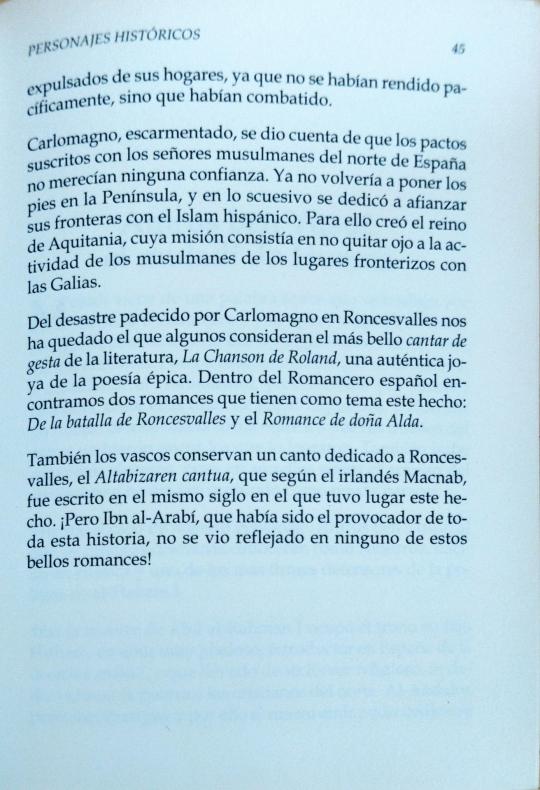
expelled from their homes, since they had not surrendered peacefully, but had fought.
Charlemagne, chastened, realized that the pacts signed with the Muslim lords of northern Spain deserved no trust. He would never set foot on the Peninsula again, and subsequently dedicated itself to strengthening its borders with Hispanic Islam. For this he created the kingdom of Aquitaine, whose mission consisted of not taking our eyes off the activity of the Muslims of the places bordering Gaul.
From the disaster suffered by Charlemagne in Roncesvalles we have remains what some consider the most beautiful song of deeds of literature, La Chanson de Roland, an authentic gem of the epic poetry. Within the Spanish Ballads we find two romances that have this fact as their theme: Of the battle of Roncesvalles and the Romance of Doña Alda. The Basques also preserve a song dedicated to Roncesvalles, the Altabizaren cantua, which according to the Irishman Macnab, was written in the same century in which this event took place. But Ibn al-Arabí, who had been the originator of this whole story, was not reflected in any of these beautiful romances!
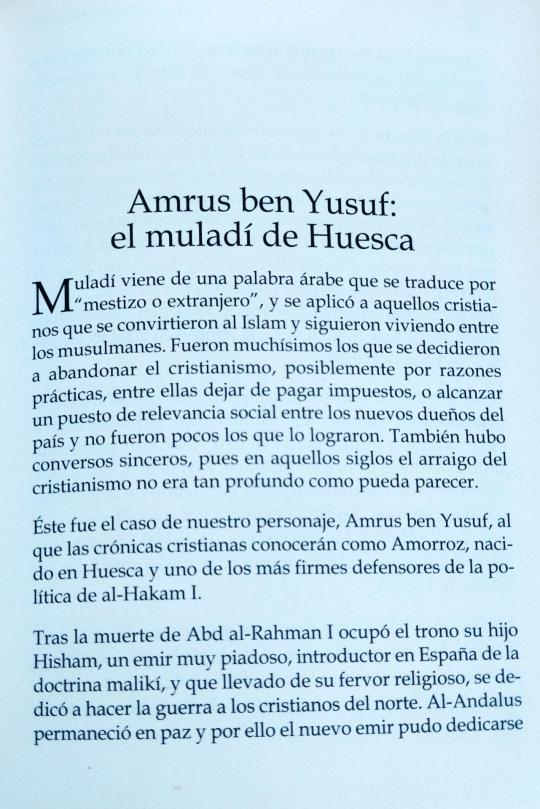
Amrus ben Yusuf: the muladí of Huesca
Muladí comes from an Arabic word that translates as "mixed race or foreigner", and was applied to those Christians who converted to Islam and continued living among the Muslims. There were many who decided to abandon Christianity, possibly for practical reasons, including stopping paying taxes, or reaching a position of social relevance among the new owners of the country and there were not a few who achieved it. There was also sincere converts, since in those centuries the roots of the Christianity was not as deep as it may seem.
This was the case of our character, Amrus ben Yusuf, whom the Christian chronicles will know him as Amorroz, born in Huesca and one of the staunchest defenders of the policies of al-Hakam I. After the death of Abd al-Rahman I, his son Hisham, a very pious emir, introducer of the Maliki doctrine in Spain, and who Driven by his religious fervor, he dedicated himself to waging war on the Northern Christians. Al-Andalus remained at peace and therefore the new emir was able to dedicate himself
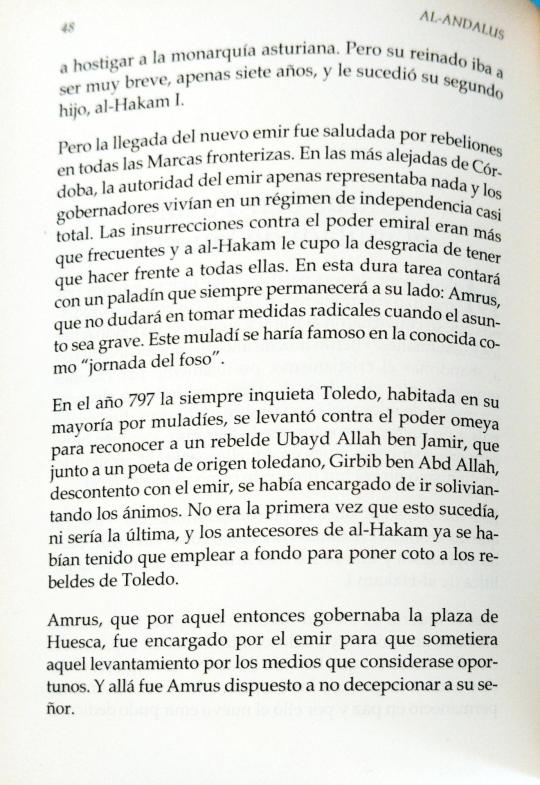
to harass the Asturian monarchy. But his reign was to be very short, just seven years, and was succeeded by his second son, al-Hakam I.
But the arrival of the new emir was greeted with rebellions in all the border marches. In the most remote areas of Córdoba, the authority of the emir hardly represented anything and the governors lived in a regime of almost total independence. The insurrections against the power of the emirate were more than frequent and al-Hakam had the unfortunate luck to have to face them all. In this hard task, he will have a paladin who will always be at his side: Amrus, who will not hesitate to take radical measures when the matter is serious. This muladí would become famous on what was known as the “day of the pit.”
In the year 797, the always restless Toledo, inhabited mostly by muladíes, rose up against the Umayyad power to recognize a rebel Ubayd Allah ben Jamir, who together with a poet of Toledo, Girbib ben Abd Allah, dissatisfied with the emir, had in charge of calming down the spirits. It wasn't the first time this happen, nor would it be the last, and al-Hakam's predecessors had already had to work hard to put a stop to the rebels of Toledo.
Amrus, who at that time ruled the stronghold of Huesca, was commissioned by the emir to subdue that uprising by the means that it considers opportune. And there went Amrus willing not to disappoint his lord.
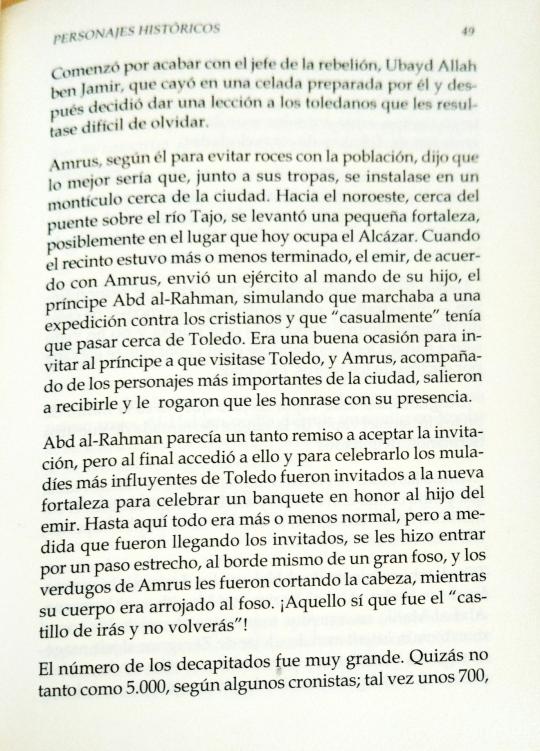
He began by eliminating the leader of the rebellion, Ubayd Allah ben Jamir, who fell into a trap prepared by him and then decided to give a lesson to the people of Toledo that they would find difficult to forget.
Amrus, according to him to avoid friction with the population, said that the best would be that, along with his troops, he would settle on a mound near the city. Towards the northwest, near the bridge over the Tagus River, rose a small fortress, possibly on the site now occupied by the Alcazar. When the enclosure was more or less finished, the emir, in agreement with Amrus, he sent an army under the command of his son, the prince Abd al-Rahman, pretending that he was going on an expedition against the Christians and that "coincidentally" had to pass near Toledo. It was a good occasion to invite the prince to visit Toledo, and Amrus, accompanied by the most important people of the city, they came out to receive him and begged him to honor them with his presence.
Abd al-Rahman seemed somewhat reluctant to accept the invitation, but In the end he agreed to it and to celebrate it the most influential mula-díes of Toledo were invited to the new fortress to celebrate a banquet in honor of the emir's son. Until then everything was more or less normal, but as the guests arrived, they became enter through a narrow passage, at the very edge of a large ditch, and the Amrus's executioners cut off their heads, while their bodies was thrown into the pit. That was the " castle of you will go and no you will come back"!
The number of those beheaded was very large. Maybe not as much as 5,000, according to some chroniclers; maybe about 700

being a very high number. What the leading class of Toledo was thus beheaded and the terrible impression produced by this event remained, for a long time, both among the Muslims and among the muladies of Toledo and from other cities.
Dozy narrates that terrible day like this: "At daybreak, a doctor that had not seen anyone leave through either of the two door, became suspicious and asked the people gathered near the entrance of the castle what had happened to the guests who had arrived early. "They must have gone out through the other door," they answered- It's strange!-the doctor then objected -; I have been for some time at the other door and I haven't seen anyone leave. After watching the steam rising above the walls, exclaimed:
Unfortunates! I swear to you that this vapor is not the smoke of a feast, but the vapor of the shed blood of your brothers, beheaded"
When things got really bad, al-Hakam knew that he could count on Amrus and so he also entrusted him with the submission of Zaragoza, the capital of the Upper March, as seditious as Toledo.
After the advent of al-Hakam, the two best generals of his father, Abd al-Karim ben Mugith and his brother, Abd al-Malik, in those moments at enmity with the new emir, they tried to evict the Aragonese chief Bahlul ben Marzuq from Zaragoza, to They settled in the city, but they did not succeed. He got a Cordoban army, and
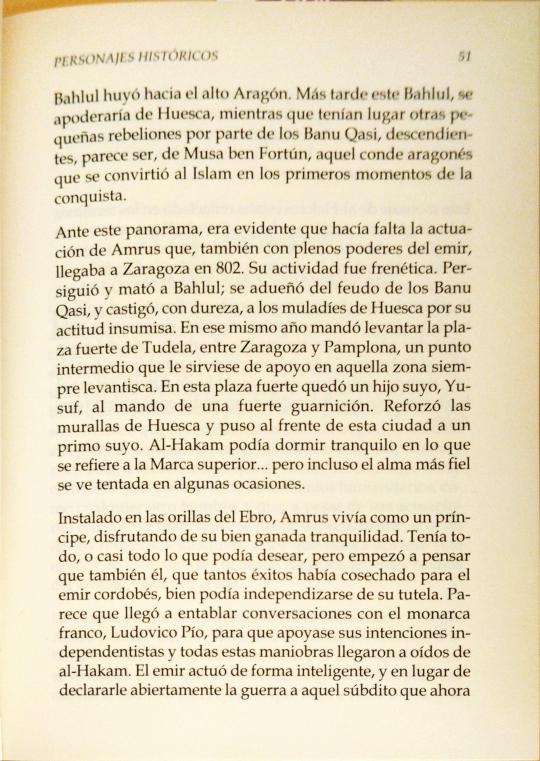
Bahlul fled towards upper Aragon. Later this Bahlul, would take over Huesca, while other small rebellions by the Banu Qasi took place, who were descendants, it seems, of Musa ben Fortún, that Aragonese count who converted to Islam in the first moments of the conquest.
Given this panorama, it was evident that the action of Amrus who, also with full powers of the emir, came to Zaragoza in 802. Its activity was frenetic. Persecuted and killed Bahlul; took over the fiefdom of the Banu Qasi, and harshly punished to the muladíes of Huesca for their rebellious attitude. In that same year he ordered the construction of the stronghold of Tudela, between Zaragoza and Pamplona, an intermediate point that would serve as support in that always upheaval area. In this stronghold there was his son, Yusuf, commanding a strong garrison. He reinforced the walls of Huesca and put one of his cousins in charge of this city. Al-Hakam could sleep peacefully when it came to the Upper March... but even the most faithful soul is tempted in some occasions.
Installed on the banks of the Ebro, Amrus lived like a prince, enjoying your well-earned peace of mind. He had everything, or almost everything he could want, but he began to think that he too, which had garnered so much success for the emir of Cordoba, could become independent of his tutelage. It seems that he came to engage conversations with the Frankish monarch, Louis the Pious, so that supported their independence intentions and all these maneuvers reached al-Hakam's ears. The emir acted intelligent, and instead of openly declaring war on that subject that now
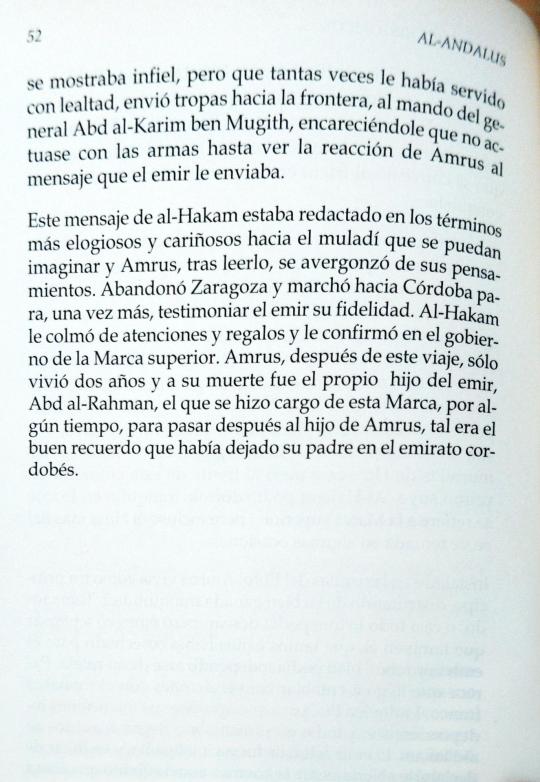
showed to be unfaithful, but that he had served him so many times with loyalty, he sent troops to the border, under the command of General Abd al-Karim ben Mugith, urging him not to act with the weapons until seeing Amrus's reaction to the message that the emir gave him.
This message from al-Hakam was written in the most praiseworthy and affectionate towards the muladí that you can imagine and Amrus, after reading it, was ashamed of his thoughts. He left Zaragoza and marched towards Córdoba to, once again, bear witness the emir his fidelity. Al-Hakam showered him with attention and gifts and confirmed him in the government of the Upper March. Amrus, after of this trip, he only lived two years and at his death the son of the emir, Abd al-Rahman, took charge of this March, for some time, to later pass to the son of Amrus, such was the good memory that his father had left in the emirate of Cordoba.
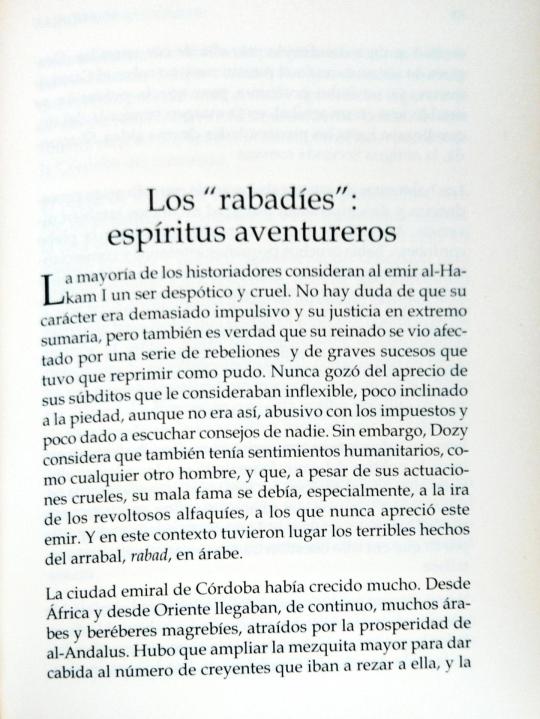
The "Rabadis": adventurous spirits
Most historians consider the emir al-Ha-kam I despotic and cruel. There is no doubt that his character was too impulsive and his justice extremely summary, but it is also true that his reign was affected by a series of rebellions and serious events that he had to repress as best he could. He never enjoyed the appreciation of his subjects who considered him inflexible, little inclined to piety, although it was not like that, abusive with taxes and little given to listening advice from no one. However, Dozy believes that he also had humanitarian feelings, like any other man, and that, despite of his cruel actions, his bad reputation was due, especially, to the wrath of the rebellious alfaquis, whom this emir never appreciated. And in this context, the terrible events of the suburb, rabad in Arabic, took place.
The emiral city of Córdoba had grown a lot. From Africa and from the East any Arabs and Berbers from the Maghreb continually arrived attracted by the prosperity of al-Andalus. The mosque had to be expanded larger to accommodate the number of believers who came to pray to it, and

The city was expanding beyond its walls. After the Roman bridge over the Guadalquivir was restored, there was no longer a problem for the population to settle in a suburb on the left bank of the river, which reached the vicinity from a village, Shaqunda, ancient Roman Secunda.
The inhabitants of this suburb were of very diverse origins and they carried out a multitude of diverse jobs. Besides of what could be considered the Cordoba plebs, there were many small Mullawad and Christian artisans and merchants, but due to its proximity to the main mosque and the emiral palace, many Cordobans who were employed, either in the mosque or in the palace, they settled there. Among this diverse population, also found the alfaquíes, religious leaders of the doctrine Malikí, who had reached a very prominent position and a very notable influence at court, especially with the emir Hisham, father of al-Hakam I.
This suburb will soon become a focus of discontent towards the emir's policy, promoted by the same alfaquies who with al-Hakam had neither the appreciation nor the influence that they achieved with his predecessor. On the other hand, in the city al-Hakam did not enjoy of many sympathies so it was only a matter of time before the situation exploded.
And it happened that one day a rumor spread through the city that seventy-two leading citizens had been executed and that their corpses were going to be exposed, crucified, on the right bank of the Guadalquivir. The mood be-
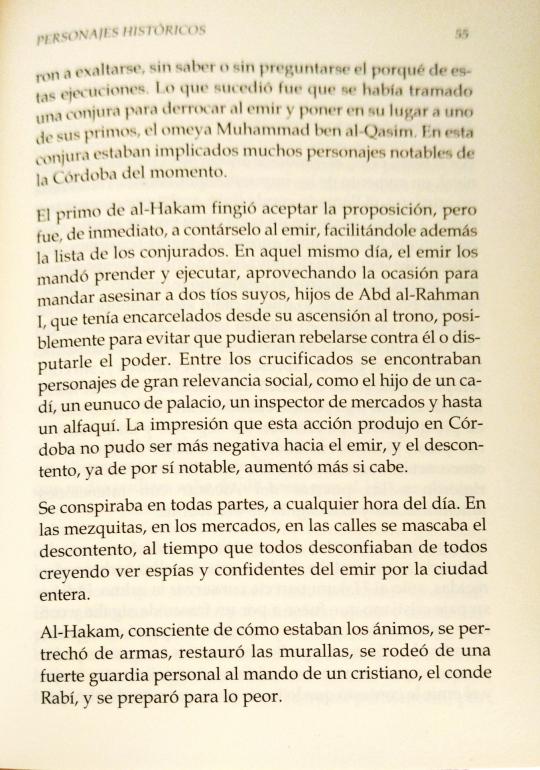
gan to exalt, without knowing or without asking themselves the reason for these executions. What happened was that a plot had been hatched to overthrow the emir and put in his place one of his cousins, the Umayyad Muhammad ben al-Qasim. Many notable people from the Córdoba of that time were involved in this conspiracy. Al-Hakam's cousin pretended to accept the proposal, but was immediately to tell the emir, also providing him with the list of the conspirators. Inthat same day, the emir ordered them to be arrested and executed, taking advantage of the occasion to order the murder of two of his uncles, sons of Abd al-Rahman I, who had been imprisoned since his ascension to the throne, possibly to prevent them from rebelling against him or challenging him for power. Between the crucified were figures of great social relevance, such as the son of a cadi, a palace eunuch, a market inspector and even a alfaqui. The impression that this action produced in Córdoba could not be more negative towards the emir, and the discontent, already notable, increased.
There was a plotting everywhere, at any time of the day. In the mosques, in the markets, in the streets discontent was chewed, while everyone distrusted everyone, believing they saw spies and confidants of the emir throughout the entire city.
Al-Hakam, aware of the mood, equipped himself withweapons, restored the walls, surrounded himself with a strong personal guard under the command of a Christian, Count Rabí, and prepared himself for the worst.
#book scans#al andalus. historical figures#al andalus. personajes históricos#al andalus#al andalus history#bookblr#historyblr#spanish history#sulayman ibn yaqzan ibn al-arabi#amrus ibn yusuf#rabadies#rabadi#al hakam i#al hakam i of córdoba#emirate of cordoba#umayyad emirate of córdoba#middle ages#rabadid dinasty#hisham i#hisham i of cordoba
10 notes
·
View notes
Text
There was no one "Moorish Empire" in Spain that lasted from 711 to 1492.
There was the Emirate and Caliphate of the Córdoba, the independent Taifa kingdoms, the Almoravids, the Almohad Caliphate, and finally the Nasrid Emirate of Granada.
All were ruled by different families of different origins: the Umayyads of Córdoba and Nasrids of Granada were Arab, the Taifa kings varied, but were mostly Arab, and the Almoravids and Almohads were both Berber.
Nor did they have the same geographic power base. The Umayyads were based in Córdoba, the Almoravids and Almohads in Marrakesh, and the Nasrids in Granada.
It wouldn’t be historically accurate for my story to include BIPOC!
This is an argument often made about European-style fantasy media like Game of Thrones, Lord of the Rings, and Disney’s Frozen. Audiences, often white, assume that due to the majority-white setting, adding any visible number of BIPOC to the story would be unrealistic.
What these critics fail to realize is that BIPOC do in fact live, and have lived, in these settings, and records of BIPOC presence in places assumed to be majority-white have been buried, written out, or not taught due to white supremacist and/or colonial bias in the field of history. There are historical European settings that were far more diverse than is often portrayed. Consider:
The Moorish Empire exerted an extensive influence over life and culture in Southern Europe from Spain from 711 to 1492
The Ottomans were heavily involved in European affairs up until the treaty of Karlowitz in 1699, but still considered a part of Europe even through the 19th century
The sheer size of the Roman Empire ensured the continued movement of people from various backgrounds within the Mediterranean well until the end of the Byzantine Empire.
“Historical accuracy” should not be used as an excuse for media to be exclusively white in its casting. While there are places which are or were predominantly white, there will always be factors like global trade and immigration that bring multiculturalism to their doors.
And even if the presence of a certain demographic is unrealistic for a certain setting? Consider that we’ve accepted far worse inaccuracies in historical fiction in the name of artistic license. Consider that our understanding of human history is, and will always be, incomplete.
Further Reading:
Historically Diverse London, “Historical Accuracy,” and Creator Accountability
Making a Black Pride and Prejudice Resonate
---
This Q&A is an excerpt from our General FAQ for Newcomers, which can be found in our new Masterpost of rules and FAQs. If you're new to Writing With Color and/or want more writing resources, check it out!
-Writing With Color
3K notes
·
View notes
Text
Today the Church remembers SS. Peter, Walabonsus, Sabinian, Wistremundus, Habentius and Jeremiah, Martyrs.
Orate pro nobis.
Peter, Walabonsus, Sabinian, Wistremundus, Habentius and Jeremiah are numbered among the Martyrs of Córdoba, forty-eight Christian martyrs who were executed under the rule of Muslim administration in Al-Andalus (name given to Spain under Islamic rule). The hagiographical treatise written by the Iberian Christian and Latinist scholar Eulogius of Córdoba describes in detail the executions of the martyrs for capital violations of Islamic law (sharīʿa), including apostasy and blasphemy. The martyrdoms recorded by Eulogius (the only contemporary source) took place between 850 and 859 AD, which, according to the Mālikī judges of al-Andalus, broke the treaty signed between Muslims and their Christian subjects.
In 711 AD, a Muslim army of Moors from North Africa invaded and conquered the territories that previously belonged to the Visigothic Kingdom of Spain, which comprised the Christian Iberia peninsula. Under their leader Tariq ibn-Ziyad, they landed at Gibraltar and brought most of the Iberian Peninsula under Islamic rule in an eight-year campaign. The Iberian Peninsula was called Al-Andalus by its Muslim rulers. When the Umayyad caliphs were deposed in Damascus in 750 AD, the dynasty relocated to Córdoba, ruling an emirate there; consequently the city gained in luxury and importance, as a center of Iberian Muslim culture.
Once the Muslims had conquered Iberia, they governed it in accordance with Islamic law (sharīʿa). Blasphemy and apostasy from Islam were both capital offenses. In the Islamic religion, blasphemy includes insulting Muhammad and the Muslim religion. Apostasy is the crime of converting away from Islam. Under Islamic law, anyone whose father is Muslim is automatically a Muslim at birth and will automatically be guilty of apostasy if they proclaim any faith other than Islam. Anyone found guilty of either blasphemy or apostasy is swiftly executed in accordance with the Islamic death penalty.
The forty-eight Christians (mostly monks) were martyred in Córdoba, between the years 850-859 AD, being decapitated for announcing their apostasy publicly and blaspheming against Mohammed.
Peter, Walabonsus, Sabinian, Wistremundus, Habentius and Jeremiah were all murdered on June 7, 851 AD. Peter was a priest; Walabonsus, a deacon; Sabinian and Wistremundus, monks of St Zoilus in Córdoba in Al-Andalus; Habentius, a monk of St Christopher's; Jeremiah, a very old man, had founded the monastery of Tábanos, near Córdoba. For publicly denouncing Muhammad they were executed under Abderrahman in Córdoba. Jeremiah was scourged to death; the others were beheaded.
Almighty God, who gave to your servants Peter, Walabonsus, Sabinian, Wistremundus, Habentius and Jeremiah boldness to confess the Name of our Savior Jesus Christ before the rulers of this world, and courage to die for this faith: Grant that we may always be ready to give a reason for the hope that is in us, and to suffer gladly for the sake of our Lord Jesus Christ; who lives and reigns with you and the Holy Spirit, one God, forever and ever.
Amen.
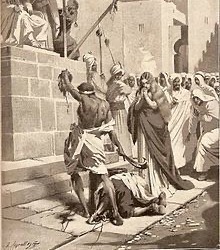
#father troy beecham#christianity#jesus#saints#god#salvation#peace#martyrs#faith#early church#christian persecution#Islam
1 note
·
View note
Text
Cordoba 2
The Caliphate of Cordoba was an Andalusian state ruled by the Umayyad dynasty, after the self-proclamation of Emir Abderraman III as caliph in 929. Its territory covered Iberia and part of North Africa, with its capital in Cordoba.
👉 Only at www.theworldgonecrazytshirts.com










#Cordoba #Córdoba #Andalusia #Spain #courtyardsofCordoba #WorldHeritageSite #theworldgonecrazy #twgc #tshirts #camisetas
1 note
·
View note
Text
On this day (26 December, 1489 CE {22/23 Muharram, 895 AH}), the Andalusian city of Almería fell to the joint monarchy of Castile and Aragon that would later become Spain.
The city was founded by the famous Umayyad Emir of Córdoba and later the first Umayyad Caliph of Córdoba, Abdur-Rahman III, in the year 955 CE.
Its Muslim population was almost entirely composed of indigenous (Iberian) converts to Islam, who were later joined by southern Arabian (Yemeni) tribes who settled in the region.
Pictured is the Alcazaba of Almería (Alcazaba de Almería/Citadel of Almería) which was founded by the aforementioned Abdur-Rahman III, and which gave this city its name: "al-Mariyyah" or "the Watchtower".
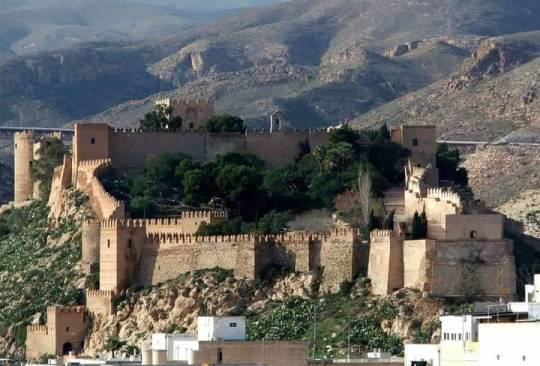
#islam#muslim#history#islamic history#history blog#umayyad#spaintravel#spain#almeria#almería#al andalus#andalusia#andalus
6 notes
·
View notes
Text
History: Córdoba's Stunning Mosque-cathedral Showcases Spain's Muslim Heritage
Christian forces captured the Umayyad capital in 1236, but left its glorious house of worship largely untouched when converting it to a cathedral.
— By Yolanda Victoria Olmedo Sánchez | 17 August 2022

The artistic styles of Islam and Christianity are visible almost everywhere in the mosque-cathedral of Córdoba—from the Renaissance cathedral in the center to the lush green orange tree courtyard. Photograph By S. Deng, Alamy, ACI
On June 30, 1236, King Ferdinand III of Castile entered the city of Córdoba, putting an end to the five-month siege that his troops had staged around the square. The Spanish Reconquista of Islamic Andalusia was advancing, and Córdoba, capital of the Umayyad caliphate in the 10th century, was the latest to fall. It had once been the brightest and most populous city in Al Andalus. It was also home to one of the world’s marvels of architecture: the Aljama Mosque.
A day before the king entered Córdoba, after the Muslims had already abandoned it, a group of Castilians left the place where they were encamped, entered the walled city through the Algeciras Gate, and went to the Great Mosque. They placed a cross and a flag of Castile atop the minaret. A few hours later, the bishop of Osma sanctified the building and celebrated a dedication mass after consecrating the altar. In a few moments, the magnificent Aljama Mosque had become a Christian cathedral.

The Córdoba mosque was expanded several times by Muslim rulers. The vast colonnaded area appears larger than it is, as the repeating patterns creates an illusion of infinite space. Photograph BY Alamy, ACI
Marvellous Mosque
The new beginning decreed by Ferdinand III in 1236 was not the first transformation of the site at the foot of the Sierra Morena in southern Spain. Legend has it that when Romans founded Córdoba in the second century B.C., they built a temple there dedicated to Janus, the two-faced god of new beginnings. Some 800 years later, the Visigoths took control of much of the Iberian Peninsula. In A.D. 572, Visigothic King Leovigilido captured Córdoba, and a Christian basilica was built there.

People kneel in prayer at the Royal Chapel of the mosque-cathedral in Córdoba, Spain, in this 1836 engraving by Charles Joseph Hullmandel. Photograph By Bridgeman, ACI
The next “new” beginning came nearly two centuries later when the expanding Umayyad empire pushed into the Iberian Peninsula from North Africa around 711. Muslim forces would soon control most of the peninsula and named it Al Andalus. A provincial capital was established at Córdoba, while the caliphate capital remained in Damascus, Syria.
A few decades later, around 750, power in Damascus changed hands from the Umayyads to another powerful Muslim faction, the Abbasids. Afraid for his life, Abd al-Rahman, a son of an Umayyad prince, fled from Damascus. After a harrowing flight across North Africa, he escaped to the Iberian Peninsula and crossed into Al Andalus. Al-Rahman contacted several allies and defeated the existing governor, setting up his new capital in Córdoba, which now became a Muslin emirate with Abd al-Rahman I ruling as its emir. It was the beginning of a period of growth and glory for the city.
Once his position seemed secure, al-Rahman demolished the Visigothic basilica and in 786 began construction of a new sacred structure on the site. The city flourished, becoming a centre of learning and culture as splendid works of architecture arose throughout the whole of Al Andalus. The death of al-Rahman in 788 did not halt work on the grand mosque, which had yet to be completed. His son Hisham and their successors would continue the work for two centuries.

During his stay in Córdoba in 1833, the British painter David Roberts wrote: “The lion of Cordova is the Mosque, once second only to that of Mecca. ... I find from the ground-plan which I have taken that there are 632 pillars of polished marble, ... some of them very exquisite in proportion.” Roberts’s vibrant 1849 painting shows the mihrab in the background. Photograph By Bridgeman, ACI
One of the mosque’s most iconic features is its massive hypostyle prayer hall filled with soaring symmetrical columns, some of which were salvaged from ancient Roman structures. Topped by colourful arches of stone and red brick, these columns stretch out almost endlessly, as row upon row makes the room feel larger and more expansive.
A focal point in the prayer hall is the mihrab, a prayer niche used in mosques to signify which wall faces Mecca, birthplace of Islam. An intricately decorated golden arch frames the mihrab, calling attention to the sacred space. Soaring above, a roof of intersecting ribs form a spectacular, segmented dome.
Sparing no expense, the Umayyad rulers who followed continued to embellish the mosque. A courtyard, fountains, an orange grove, and a covered walkway were all added to the complex. Perhaps most notable was a minaret, the tower used to call Muslims to prayer. Abd al-Rahman III built what some historians consider the mosque’s first true minaret in 951-52. The original minaret’s floor plan was square, and the structure narrowed as it rose. On the top perched a gilt bronze dome topped by an iron finial, called a yamur in Islamic architecture.

In the shadow of the mosque-cathedral’s bell tower along its north wall, the altar of the Virgin of the Lanterns is illuminated at night. Photograph By Anna Serrano, GTRES
Preservation and Change
Civil war weakened Umayyad control of Al Andalus in the early 11th century, which would later allow Ferdinand III and his forces to take the city in 1236. The Castilians might have radically changed the Great Mosque’s spiritual function, but they certainly weren’t going to destroy it. They recognised the magnificence of the architecture, and many Christian writers praised it. Don Juan Manuel, grandson of Ferdinand III, mentions the Great Mosque in his story collection The Tales of Count Lucanor (1335), with a character describing it as “one of the most beautiful mosques the Moors had in Spain, glory to God! it is now a church, called ‘Saint Mary of Cordova.’ It was dedicated, by the ‘good King Ferdinand,’ to Saint Mary after he had taken Cordova from the Moors.” In the mid-15th century, the Cordoban writer Jerónimo Sánchez also expressed his great admiration: “a temple worthy of all praise, whose exceedingly pleasing beauty revives the spirit of those who behold it,” even a “wonder of the world.”
In the first two centuries of Christian rule, existing spaces were adapted for Christian worship, but structural alterations were few. Much of it was carried out in the Mudejar style, which combined Christian artistic currents with Muslim architectural and decorative traditions. The so-called Royal Chapel was one of the earliest. Built in the 1370s, it combines a tiled plinth, plasterwork, a beautiful ribbed vault, and stalactite-like muqarnas (ornamented vaulting). After the building’s consecration as a Christian church, the minaret was converted into a bell tower.

Begun in 1371, the Royal Chapel was funded by Spain’s King Henry II in order to house the remains of his ancestors. The square enclosure is covered with a vault of interlocking arches. The image shows one of the two main walls, with an arcade and splendid plasterwork decoration. Photograph By Alamy, ACI
The most obvious change made to the mosque during the first phase of Christian rule was the addition of numerous private chapels along the inner walls of the complex. The city’s most illustrious families were buried here, and there is evidence that the chapel construction began shortly after the Christian conquest of the city. One of the earliest was in 1262, when a man named Juan Pérez Echán signed an agreement allowing him to construct a chapel delimited by lattices and with an altar inside.
The end of the 15th century and beginning of the 16th saw the most significant alterations to the structure. The first significant transformation of its interior took place between 1486 and 1496 when Bishop Íñigo Manrique had a long Gothic nave built in front of the Main Chapel, a complex later called the Chapel of Villaviciosa. This space had served as the focal point of Christian worship since Ferdinand III’s forces captured Córdoba, thanks to the skylight installed by Hakam II in the 10th century.
Later renovations were largely directed by the Ruiz dynasty of architects: Hernán Ruiz, father, son, and then grandson, held the position of master builder at the cathedral. They designed and oversaw construction and were responsible for dealing with any technical problems. Hernán Ruiz I (also known as Hernán Ruiz the Elder) oversaw the transformation of the mosque’s courtyard into a Gothic-Mudejar cloister.

After seizing Córdoba in 1236, Castilian Christians performed their first Mass underneath the splendid skylight installed by Hakam II. This part of the mosque would later be renovated and become known as the Chapel of Villaviciosa. Photograph By Günter Gräfenhain, Fototeca 9X12
Changes to the Main Chapel
The building of a new Main Chapel and a new choir designed by Hernán Ruiz was a turning point in the mosque’s transformation. The project involved moving the Main Chapel to the cathedral’s centre, where, according to Bishop Alonso Manrique, “it would be better than where it is now, as that is a corner of the church.”
The project caused great controversy and huge clashes between members of the city council and the cathedral chapter. Various councillors, then known as Veintiquatros (the Twenty-Four), owned private chapels in and around the cathedral’s original Main Chapel. They worried that these would lose prestige if the main worship space were moved (spaces closer to the central place of worship were higher status). There was also concern about destroying a considerable section of the original mosque, which, according to one of the statements in protest, “because of the way it is built, is unique in the world.”

Top: Construction of the cathedral’s Main Chapel began in 1523. It was placed in the center of the original mosque and adorned with more traditional Christian artworks, including a 17th-century marble altarpiece and paintings honoring the Assumption of the Virgin Mary. Photograph By Manuel Cohen, AurImages
Bottom: One of the most recent additions is this chapel, built at the end of the 16th century. It includes three naves and is covered with a ribbed vault. Representations of Cordoban saints appear around a central painting of the Last Supper, following a design prepared by the humanist Ambrosio de Morales. Photograph By W. Cezary, Alamy, ACI
The dispute became so heated that the Veintiquatros argued that“the workmanship that is being undone is of a quality that could not be remade with the same goodness and perfection.” They even threatened to harm those working on the demolition, but Bishop Alonso Manrique, determined that the work should proceed, responded by excommunicating them and then appealed to the crown. King Charles V gave his approval for additions at the old mosque complex’s centre, and construction began in fall 1523.
Three years into the project, Charles V travelled to Córdoba with his new wife Isabella of Portugal and visited the cathedral to see how the project was progressing. Allegedly, he was disappointed with the renovations that he himself had approved. Tradition has it that he delivered a rather scathing critique of the job: “You have destroyed something unique to build something commonplace.”
For the new Main Chapel, Hernán Ruiz I designed a rectangular chapel that would stand at the complex’s centre. It had three naves, the central one higher and wider than the two to the sides. A magnificent dome rose above the central crossing. He used slightly pointed arches for the central nave and ribbed vaults for the lateral ones. The sense of height was accentuated by incorporating arches from the old mosque. His aim was to integrate the Christian temple without losing the original Muslim oratory’s splendour. Opinions remain divided on the result.
Building work continued for several decades. His son, Hernán Ruiz the Younger, built the apse and the arms of the transept and vault in the apse of the Main Chapel, which he had decorated with Gothic openwork and images of the Virgin Mary. When Hernán Ruiz II died in 1569, the crossing’s construction was halted for 30 years, starting again at the end of the 16th century, during the time of Bishop Francisco Reinoso. The master builder, Juan de Ochoa, added a lowered barrel vault decorated with intricate plasterwork by Francisco Gutiérrez Garrido.

The interior walls of the mosque-cathedral are dotted with chapels, as shown in this drawing, which shows the area around the Parroquia del Sagrario. Photograph By Oronoz, Album
Another new space dedicated to worship was the Chapel of the Sacrarium, in the southeast corner of the complex, with a façade built by Hernán Ruiz III. The wall paintings inside were made in 1583 by the Italian painter Cesare Arbasia, and depict the Eucharist and various Cordoban martyrs, following a design by the Cordoban humanist Ambrosio de Morales. In 1589 an earthquake caused major structural damage to the bell tower, and a new one was built, incorporating remnants of the old minaret. It was designed by Hernán Ruiz III and crowned with a sculpture of St. Raphael.
Later, during the Renaissance and Baroque periods, private chapels were added to the mosque-cathedral, some sumptuous in their decoration. The Chapel of Our Lady of Conception carved in marble on the west flank of the cathedral was the work of Melchor de Aguirre between 1679 and 1682. It was endowed by Bishop Fray Alonso de Medina Salizanes as a burial chapel. Between the end of the 17th century and the beginning of the 18th, another funerary space was built at the south end: the Chapel of St. Teresa (also known as the Chapel of Cardinal Salazar), a work in Baroque style by Francisco Hurtado Izquierdo and Teodosio Sánchez de Rueda. The Chapel of Saint Inés was built in neoclassical style in the latter half of the 18th century.

Viewed from the south, the complex’s interconnected warren of small chapels, sacred doors, and fragrant gardens surrounds the breathtaking hypostyle hall and central cathedral. Photograph By Illustration By SOL90, Album
Visitors to the mosque-cathedral have never failed to be impressed by its beauty and the way it embraces the visual styles of two separate faiths. In 1984 the mosque-cathedral of Córdoba became a UNESCO World Heritage site. In 1994 UNESCO added nearly 200 acres to its listing, including part of the city’s historic center, the fortress (or Alcázar), and south to the Guadalquivir River’s far bank, the Roman Bridge, and the Calahorra Tower. With this designation, the mosque-cathedral of Córdoba and its site will be studied, appreciated, and renewed for many generations to come.
5 notes
·
View notes
Text

🕌⛩️🕌THE GREAT MOSQUE OF CÓRDOBA مسجد قُرطبة الكبير – SPAIN 🇪🇸
Groundbreaking :(784 -786 AD,167 -170 AH)
The Great Mosque was built in the context of the new Umayyad Emirate in Al-Andalus which Abd ar-Rahman I founded in 756. Abd ar-Rahman was a fugitive and one of the last remaining members of the Umayyad royal family which had previously ruled the first hereditary caliphate based in Damascus, Syria. This Umayyad Caliphate was overthrown during the Abbasid Revolution in 750 and the ruling family were nearly all killed or executed in the process. Abd ar-Rahman survived by fleeing to North Africa and, after securing political and military support, took control of the Muslim administration in the Iberian Peninsula from its governor, Yusuf ibn Abd al-Rahman al-Fihri. Cordoba was already the capital of the Muslim province and Abd ar-Rahman continued to use it as the capital of his independent emirate.
The original structure was built in 784–786 AD (167–170 AH) with extensions in the 9th and 10th centuries that doubled its size, ultimately making it one of the largest sacred buildings in the Islamic world. The ground plan of the completed building forms a vast rectangle measuring 590 by 425 feet (180 by 130 metres), or little less than St. Peter’s Basilica in Rome. About one-third of this area is occupied by the Patio de los Naranjos (“Court of the Oranges”) and the cloisters that surround it on the north, east, and west. Passing through the courtyard, one enters on the south a deep sanctuary whose roof is supported by a forest of pillars made of porphyry, jasper, and many-coloured marbles. Some 850 pillars divide this interior into 19 north-to-south and 29 east-to-west aisles, with each row of pillars supporting a tier of open horseshoe arches upon which a third and similar tier is superimposed. The most exquisite decoration in the whole complex is found in the third mihrab, or prayer niche, a small octagonal recess roofed with a single block of white marble that is carved in the form of a shell and has walls inlaid with Byzantine-style mosaics and gold.
Since 1236 AD the former mosque has served as a Christian cathedral, and its Moorish character was altered in the 16th century with the erection in the interior of a central high altar and cruciform choir, numerous chapels along the sides of the vast quadrangle, and a belfry 300 feet (90 metres) high in place of the old minaret.
The mosque structure is regarded as an important monument in the history of Islamic architecture and is considered by many scholars to have been highly influential on the subsequent "Moorish" architecture of the western Mediterranean regions of the Muslim world.It is also one of Spain's major historic monuments and tourist attractions ,as well as a UNESCO World Heritage Site since 1984 (1404 AH).
🕌 ⛩️ 🕌 ⛩️ 🕌 ⛩️ 🕌ordoba
4 notes
·
View notes
Text
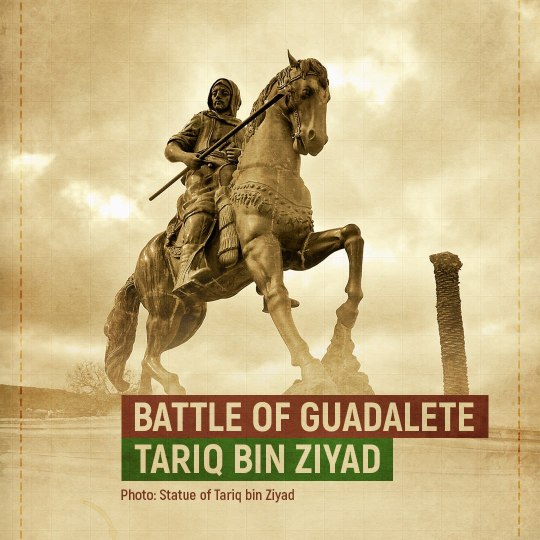
On the 27th of Ramadan, 92 Hijri (July 19, 711), Berber Umayyad commander, Tariq bin Ziyad defeated king Roderic of the Visigothic Kingdom at the Battle of Guadalete (in southern Spain).
This victory of Tariq marked the beginning of the Umayyad conquest of Hispania. King Roderic was also killed in the battle. The Iberian peninsula soon became part of the expanding Umayyad empire, under the name of al-Andalus.
After the fall of the Umayyads in the east in 750 CE, Abd al-Rahman I, a member of the Umayyad dynasty, refused to recognize the authority of the Abbasid Caliphate and fled Damascus. As a result, in 756, he established the Emirate of Córdoba and became an independent emir of Córdoba.
The Nasrid Kingdom of Granada was the last independent Muslim state in Western Europe, which ruled from 1230 to 1492. After its fall in 1492, the new Christian state of Spain took a very aggressive religious conversion approach against the non-Christian population of the Iberian peninsula. Both the Jews and the Muslims were forced to convert and then be expelled as part of the Spanish Inquisition.
Join us on Telegram
https://t.me/fiveminthistory
Support us
https://www.patreon.com/fiveminthistory
1 note
·
View note
Text
Al Andalus II: One of the world’s greatest civilizations; Times of glory, Part 2.
Previous parts:
Al Andalus I: The dawn of one of the world’s greatest civilizations.
Al Andalus II: One of the world’s greatest civilizations; Times of Glory, Part 1.
Al Andalus II: One of the world’s greatest civilizations; Times of Glory, Part 2.
Al Andalus III: One of the world’s greatest civilizations; The Downfall and end, Part 1.
Al Andalus III: One of the world’s greatest civilizations; The Downfall and end, Part 2.

Córdoba
II. The following Two great Abd al Rahman
Repentant and apologetic, Al Hakam I, as said earlier, put his kindest and wisest son as a successor. This kind and wise son was Abd al Rahman II (the middle one)(822-852 AC.).
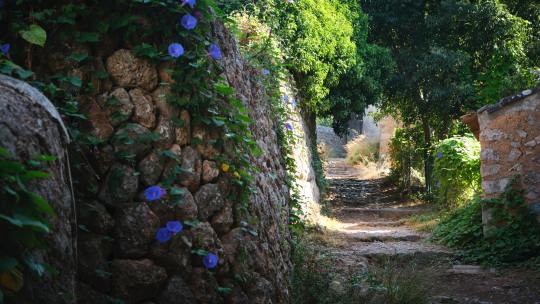
Garden in Spain
Abd al Rahman II (the middle one)(822-852 AC.)
He would prove to be the best gift Al Hakam II could ever give to the citizens of al Andalus. Abd al Rahman (the middle one) reorganised the country's economy and made sure that there were no poor people in al Andalus. As most of the Umayyad Emirs, he had a love for knowledge, he promoted scholars and academics, which is why we heard about scholars like Abbas ibn Firnas during his rule.
Abbas ibn Firnas; inventor of glass, the first airplane, devices to tell time, and the father of the predecessor of the pen.
Abd al Rahman II also fought a constant battle with the christian northern provinces. In his reign, Seville was attacked by Vikings, and as a result of this attack he ordered the construction of the so-called “Great wall of Seville”. This wall was built as extra protection to the already existing wall to safeguard the city and the “Guadalquivir” river and its outflow in the atlantic ocean.
Another accomplishment worth mentioning is the introduction of a new irrigation system which was a genius invention at the time. He was also responsible for paving all the streets in the country. After 30 years of successful rule, Abd el Rahman the “middle one” died, and with his death came a steep decline in the country.
* Muhammad I
(852-886 AC.)
* Al Mundir
(886-888 AC.) only ruled for two years
* Abd Allah
(888-912 AC.) Grandfather of Abd al Rahman III, as his son Muhammad II died before taking the throne.

Medina Azahara, Córdoba
Abd al Rahman III (the victorious)(912-961 AC., The first calipha)
Top of the glory:
After several weak rulers, and years of focus on side issues, the country was falling apart. Abd Allah had seen his son and successor Muhammad II die an early death, he then put all his hopes and energy in raising his grandson; Abd al Rahman the victorious.
In the history of al Andalus, there were three Emirs called Abd al Rahman, all of which were the greatest rulers of the country. It is difficult to compare one to another, all three were extremely good rulers, wise and kind. All of them brought great fortune, peace and prosperity to the county. Each and every one of them got a nickname, and were loved by the citizens. Nevertheless, the accomplishments of the last Abd al Rahman, the victorious, were something else altogether.
Rise to the throne:
When Abd al Rahmen III rose to the throne instead of his father, he was only 22 years old. As previously mentioned, he was educated by his grandfather, Abd Allah ibn Muhammed, who succeeded well in raising him. Abd al Rahman III was well educated, and had a lot of self-confidence.
The situation in the country, on the other hand, was in ruins. Very little remained of the great al Andalus, and many provinces had claimed independence from the rest of the country. It was time to reorganise and reunite al andalus.
Abd al Rahmen III started with substituting Córdobas corrupt officials. The second step was dealing with the governor of Seville, Omar ibn Hafsun, who had taken matters into his own hands, and confiscated part of the country’s army for himself. He had gone even further and became independent from the rest of the country, earning his living trading with Morocco and the christian northern provinces. Abd al Rahman’s army disconnected his roots to Morocco and the north, in an attempt to cut Omar off his supplies. After months of struggle, the negotiations started and Omar soon gave in.
Seville and Jaén once again joined al Andalus. The provinces north of Córdoba that also were independent, were having constand wars with León and Navarra (the christian provinces). As a clever way of winning their trust, Abd al Rahman, brought his army, and joined the fight on the Muslims side.
Together they fought off the enemy, and the northern provinces came to the realisation that they could not survive alone. Finally they understood who their real enemy was. Shortly after, they too joined the rest of al Andalus.
Great Achievements:
With the wise tactics, fights, and diplomacy, Abd al Rahman the victorious succeeded in reuniting the whole country back to its original size, as it was in the time of general Musa. Even Aragon (Barcelona, etc.), were won back (they were lost under Al Hakam I’s rule). The last surprise was when he brought his army to fight the “Northern Provinces”.
After 6 months of battle, Abd al Rahman's army achieved great victory, and the losing provinces now agreed on paying Gizia (explained in II: Part 1).
All of these achievements were accomplished before Abd al Rahman was 33 years of age.
What he had achieved so far was exceptional and significant, and it would be more than enough to make him a prominent illustrious ruler, but Abd al Rahman's accomplishments did not stop here. Córdoba under his rule would perhaps have been the second largest city in the world, with half a million inhabitants. Baghdad, the world's most populated city, counted 2 million.
He increased the cultivation of fruits, cotton, wheat, and more. Something peculiar is that he ordered that each article had its own market, thus, one market for meat, one for gold, one for flowers, etc.
The police system was reorganised and there was a special department for the day, and another for the night. A special one for businesses, and one for marine police.
The library of Córdoba was expanded from having 4,000 books, to possessing 400,000 books. Furthermore, he instructed the copying of books by scribers, to facilitate the obtention of books for scholars and others and in that way spreading knowledge.
The presence of researchers was a new phenomenon developed during the Abd al Rahman III era. He oversaw the construction of the city of Zahra, and its castles. The city was built for everyone; workers, scholars, and of course, the castle was for the Emir and his family.
The construction of mosques also saw its climax, and the city of cordoba alone counted 3,000 mosques in that time.
The rise of the Ottomas:
Back to the Abbasids, who took the power and assassinated the Umayyads, with time, they had become weak, and the Ottomans (turkey) took over, this time, Abd al Rahman saw his chance, and declared independence from the Ottoman empire, and became himself, Andalucías first Calipha. At the end of Abd al Rahman the victorious’s reign, he even added Septa and Tangier to the list of provinces he had won, and they became united with al Andalus.
He was satisfied and peaceful. When Abd al Rahman took his last breath, Córdoba was called “The diamond of the world”. Al Andalus had now, thanks to him, become the strongest country in the world.
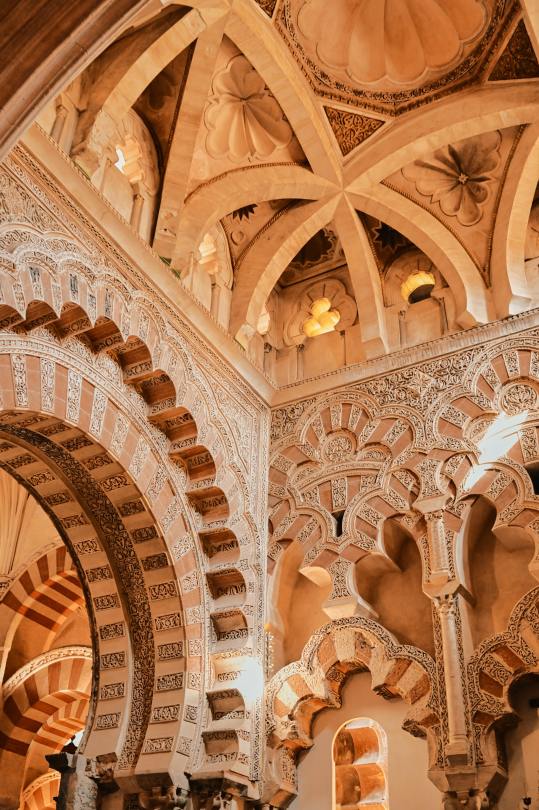
Mezquita catedral de córdoba
Al Hakam II (961-976 AC.)
The son of Abd al Rahman the Victorious was, as many of his forefathers, extremely interested in knowledge, books and education. As many of his predecessors, he surrounded himself with scholars.
During his reign, the great library of Córdoba had as many books as the library of Baghdad. The whole western world came to al Andalus for knowledge. Most of the kings of european countries, sent their children to study at al Andaluz, all the different subjects were given in Arabic, as Arabic was the world’s leading language.
Another interesting detail, as the men were busy with work, the women were the ones that studied more, and were exceptionally well educated. Furthermore, there was no one in al Andalus that was illiterate, everyone could read and write.
In the time of Hakam II, all Morocco united with al Andalus, not as a result of war, but because of the greatness of the country. Al hakam II, it has to be said, was not a great army leader, in that aspect he lived and died in the shadow of the great achievements of his father, the great Abd al Rahman.
* Hisham II
(976-1009 AC.)
* Al Mansor
(976-1009 AC.)
Conclusion:
The glory and prosperity in al Andalus had now reached its peak. Never before, or after, had the iberian peninsula experienced similar stability, prosperity, and wealth in all aspects of life.
Health, education, trade, cultivation, construction (of new cities), roads, ships, harbours, bridges, paved streets, locks, dams etc. Beauty (gardens, castles, and mosques) and new inventions.
All the different religious groups (muslims, jews, christians), ethnical groups and/or races of the society (arabs, berber, original spaniards, etc.), lived together in harmony, without discrimination; something that we could still learn from today.
The iberian peninsula had become a paradise on earth, and al Andalus the strongest country in the world!
When reaching the top, there is only one way forwards, downwards. With great beauty comes great pain.
#al andalus#spain#history#cordoba#muslims#ottomans#Alzahra#mezquita#catedral#masjid#cathedral#religion#writers on tumblr#writers#writblr
10 notes
·
View notes
Text
UNESCO World Heritage Sites: Andalucía (Andalusia)

-------------------------------------------
Andalucía has 8 world heritage sites, with 7 of them being exclusive of the area while the other one is shared between Aragón, Catalonia, Castile-La Mancha, Murcia and Valencia.
Córdoba is the city with the most Heritage Sites.
Alhambra, Generalife and Albaicín (Granada)
Type: Cultural
The Alhambra, meaning "The Red One"', is a palace and fortress complex. It was originally constructed as a small fortress in AD 889 on the remains of Roman fortifications, and then renovated and rebuilt in the mid-13th century by the Nasrid emir Mohammed ben Al-Ahmar of the Emirate of Granada, who built its current palace and walls with many beautiful, intricate details. It was converted into a royal palace in 1333 by Yusuf I, Sultan of Granada.
The Generalife, meaning "Architect's Garden", was the summer palace and country estate of the Nasrid rulers of the Emirate of Granada in Al-Andalus. The palace and gardens were built during the reign of Muhammed II (1273-1302), Sultan of Granada, and later by Muhammed III (1302–1309). They were redecorated shortly after by Abu I-Walid Isma'il (1313–1324). The Generalife is one of the oldest surviving Moorish gardens.
The Albaicín is a district of Granada. It retains the narrow winding streets of its Medieval Moorish past dating back to the Nasrid Kingdom of Granada.

Antequera Dolmens Site (Málaga)
Type: Cultural
The Antequera Dolmens Site is a cultural heritage ensemble comprising three cultural monuments (the Dolmen of Menga, Dolmen of Viera and Tholos of El Romeral) and two natural mountain features (the Peña de los Enamorados and El Torcal).
Both the Dolmen of Menga and the Tholos of El Romeral have anomalous orientations: whereas the axes of almost all dolmens around the Mediterranean are oriented to a celestial feature, such as sunrise at dawn on the equinoxes the Dolmen of Menga is the only Dolmen in continental Europe that points towards an anthropomorphic mountain (the Peña de los Enamorados) while Tholos of El Romeral is oriented to the mountains of El Torcal, containing the Cave of the Bull.

Caliphate City of Medina Azahara (Córdoba)
Type: Cultural
Medina Azahara, meaning "the Shining City", is the ruins of a vast, fortified Andalus palace-city built by Abd-ar-Rahman III (first Umayyad Caliph of Córdoba). It was the de facto capital of al-Andalus as the heart of the administration and government was within its walls.
Medina Azahara is an outstanding example of urban planning combining architectural and landscape approaches, the technology of urban infrastructure, architecture, decoration and landscape adaptation, illustrating the significant period of the 10th century CE.

Cathedral, Alcázar and Archivo de Indias (Sevilla)
Type: Cultural
The Cathedral of Saint Mary of the See is a Roman Catholic cathedral as well as the largest Gothic religious building. After its completion in the early 16th century, it supplanted Hagia Sophia as the largest cathedral in the world, a title the Byzantine church had held for nearly a thousand years. It is the resting place of Christopher Columbus and his son.
The Royal Alcázars of Seville, meaning "The Verdant Palace", is a royal palace built by Castilian Christians on the site of an Abbadid Muslim alcazar ("residential fortress") destroyed after the Christian conquest of Seville. The palace is a preeminent example of Mudéjar architecture in the Iberian Peninsula but features Gothic, Renaissance and Romanesque design elements from previous stages of construction.
The Archivo General de Indias is the repository of extremely valuable archival documents illustrating the history of the Spanish Empire in the Americas and the Philippines. The building itself, an unusually serene and Italianate example of Spanish Renaissance architecture, was designed by Juan de Herrera.


Doñana National Park (Huelva, Cádiz and Sevilla)
Type: Natural
Doñana National Park has a biodiversity that is unique in Europe, although there are some similarities to the Parc Naturel Régional de Camargue of the Camargue river delta in France. The park features a great variety of ecosystems and shelters wildlife including thousands of European and African migratory birds, fallow deer, Spanish red deer, wild boars, European badgers, Egyptian mongooses, and endangered species such as the Spanish imperial eagle and the Iberian lynx.
Due to its strategic location between the continents of Europe and Africa and its proximity to the Strait of Gibraltar, Doñana's large expanse of salt marsh is a breeding ground as well as a transit point for thousands of European and African birds (aquatic and terrestrial), and hosts many species of migratory waterfowl.

Historic Centre of Córdoba (Córdoba)
Type: Cultural
The historic centre of Córdoba is one of the largest of its kind in Europe. The historic centre has a wealth of monuments preserving large traces of Roman, Arabic, and Christian times.
Evidence of the Roman period can be seen in the bridge over the Guadalquivir, the mosaics in the Alcázar, the columns of the Roman temple, and the remains of the Roman walls. In addition to the Caliphal Baths, the Moorish influence in the city's design is evident in the Alcázar gardens adjacent to the former Grand Mosque. Minarets from the period survive in the churches of Santiago, San Lorenzo, San Juan and the Santa Clara Hermitage. The Jewish presence during Muslim rule can be seen in the La Judería district in which the synagogue was used.

Renaissance Monumental Ensembles of Úbeda and Baeza (Jaén)
Type: Cultural
The respective monumental ensembles attained their most unique constructive expressions during the Renaissance period. Úbeda developed outstanding noble architecture; Baeza turned into an important ecclesiastic and educational centre.

Rock Art of the Mediterranean Basin (Jaén, Almería and Granada, shared with other autonomous communities)
Type: Cultural
Rock art of the Iberian Mediterranean Basin, is the name given to the group of over 700 sites of prehistoric Levantine art. The sites are in the eastern part of Spain and contain rock art dating to the Upper Paleolithic or (more likely) Mesolithic periods of the Stone Age. The art consists of small painted figures of humans and animals, which are the most advanced and widespread surviving from this period, certainly in Europe, and arguably in the world, at least in the earlier works. It is notable for the number of places included, the largest concentration of such art in Europe. Its name refers to the Mediterranean Basin; however, while some sites are located near the sea, many of them are inland in Aragon and Castilla–La Mancha; it is also often referred to as Levantine Art (meaning "from Eastern Spain", not the Levant region).

#Spain#discover spain#history of spain#Spanish history#UNESCO Spain#Spanish Geography#España#Spanish food#Spainsight
9 notes
·
View notes
Text
Exspaining Spain
Monuments and landmarks
Spain is the fourth country in the world with the highest number of World Heritage Sites: forty-nine in total, of which forty-three are cultural, four are natural, and two are mixed.
Alhambra, Generalife and Albayzín in Granada
The Alhambra, Generalife and Albayzín are located in the city of Granada, Andalusia. They were built during the Muslim period.
The Alhambra is a palace and fortress complex that was originally built as a small fortress on the remains of a Roman fortification. It was renovated and rebuilt in the 13th century by the Nasrid Emir of Granada, which was the most important political and social center of the Muslim West. The Patio de los Leones (Courtyard of the Lions) is one of the most beautiful parts of the complex.
The Generalife includes the orchard and gardens, built between the 13th and 14th centuries. The Albaicín is a district of Granada that retains the characteristic narrow, winding streets of Muslim times.

Ancient and Primeval Beech Forests of the Carpathians and Other Regions of Europe
The Ancient and Primeval Beech Forests of the Carpathians and Other Regions of Europe is a transnational serial nature site that includes forests in Albania, Austria, Belgium, Bulgaria, Croatia, Germany, Italy, Romania, Slovakia, Slovenia, Spain, and Ukraine.
Those in Spain are located in Castile-La Mancha, Castile and León, Madrid, and Navarra.

Antequera Dolmens Site
The Antequera Dolmens Site is an ensemble comprising three cultural monuments (the Dolmen of Menga, Dolmen of Viera, and Tholos of El Romeral), and two natural mountain features (the Peña de los Enamorados and El Torcal) in Málaga, Andalusia. It is a magnificent example of the megalithic architecture of the Iberian Peninsula.

Aranjuez Cultural Landscape
The Aranjuez Cultural Landscape is located in Aranjuez, Madrid, and is made up of an old historical-artistic center, the royal palace, and gardens on the banks of the Tagus River.

Archaeological Ensemble of Mérida
The Archaeological Ensemble of Mérida is one of the largest and most extensive archaeological sites. It is located in Mérida, Extremadura, and comprises an amphitheater, two aqueducts, an arch, a bridge, a circus, a temple, and a theater, all dating from Roman times.

Archaeological Ensemble of Tarraco
The Archaeological Ensemble of Tarraco is located in Tarragona, Catalonia, and includes seven amphitheaters, nine aqueducts, four circus, eight forums, six theaters, and a wall, among others.

Archaeological Site of Atapuerca
The Archaeological Site of Atapuerca is located in Burgos, Castille and León. It is one of the most important archaelogical sites in Europe, as at least thirty-two human remains have been found there.

Burgos Cathedral
The Cathedral of Saint Mary of Burgos is a Catholic church dedicated to the Virgin Mary. Located in the city of Burgos, Castille and León, it was built between the 13th and 18th centuries, following the French Gothic style.

Caliphate City of Medina Azahara
Medina Azahara was a fortified palace-city on the outskirts of Córdoba, Andalusia. It was built in the 10th century by the Umayyad dynasty and served as the capital of the Caliphate of Córdoba.

Catalan Romanesque Churches of the Vall de Boí
The Churches of the Vall de Boí are a set of nine Early Romanesque churches located in Lérida, Catalonia. They were built around the 12th century.

Cathedral, Alcázar and Archivo de Indias in Seville
The Cathedral, Alcázar and Archivo de Indias are located in the city of Seville, Andalusia. The Cathedral was built in the 12th century in the Gothic style over a mosque that used to stand on the same place. The Alcázar, which dates from the 10th century, is an ensemble of Islamic-style palaces surrounded by a wall. The Archivo de Indias, built in the 16th century, stores valuable documents that allow historians to recreate the history of Spain’s relations with its American colonies.

Cave of Altamira and Paleolithic Cave Art of Northern Spain
Cave of Altamira and Paleolithic Cave Art of Northern Spain is the name under which eighteen caves in Cantabria are grouped. They represent the height of Paleolithic cave art in Europe between 35,000 and 11,000 BCE.

Cultural Landscape of the Serra de Tramuntana
The Cultural Landscape of the Serra de Tramuntana belongs to a mountain range running southwest-northeast in Majorca, the Balearic Islands. It consists of a series of rugged mountains and fertile valleys communicated by ravines.

Doñana National Park
Doñana National Park is a natural reserve in Andalusia consisting of an area of marshes, shallow streams and sand dunes, and the Guadalquivir River delta.

Garajonay National Park
Garajonay National Park is located in the center and north of the island of La Gomera, in the Canary Islands. It is the best example of Canarian laurisilva, a humid subtropical type of forest.

Heritage of Mercury. Almadén and Idrija
Heritage of Mercury. Almadén and Idrija is a joint World Heritage site in Ciudad Real, Castile-La Mancha, and Idrija, Slovenia. It encompasses two mercury mining sites. In Almadén, mercury has been extracted since Antiquity.

Historic Centre of Córdoba
The Historic Center of Córdoba, Andalusia has a wealth of monuments that showcase traces of Roman, Arabic, and Christian architecture. It includes an alcazar, public baths, a bridge, a cathedral, a hospital, a palace, a tower, and a wall.

Historic City of Toledo
Toledo is located in Castile-La Mancha and is known as the “City of the Three Cultures” for the cultural influences of Christians, Jews, and Muslims. It includes an alcazar, a castle, a cathedral, some bridges, several churches including a mosque-turned church, a museum, and two synagogues.

Historic Walled Town of Cuenca
Built by the Muslims and located in Castile-La Mancha, Cuenca is a well-preserved medieval fortified city. It includes Spain’s first Gothic cathedral and the famous casas colgadas (hanging houses).

Ibiza, Biodiversity and Culture
Ibiza, located in the Balearic Islands, is an excellent example of the interaction between marine and coastal ecosystems. It includes the archaeological sites of Sa Caleta and Puig des Molins, dating from the Phoenician-Carthaginian period.

La Lonja de la Seda de Valencia
Located in the Valencian Community, the Lonja de la Seda is a late Valencian Gothic-style building where silk used to be traded.

Las Médulas
Las Médulas is a historic gold-mining site in León, Castile and León. It was the most important gold source, as well as the largest open-pit gold mine, in the Roman Empire.

Monastery and Site of the Escorial, Madrid
The site of El Escorial in Madrid was built in the 16th century and is one of the Spanish royal sites. It houses a church, library, monastery, and royal palace.

Monuments of Oviedo and the Kingdom of the Asturias
In the 9th century, the flame of Christianity was kept alive in the Iberian Peninsula in the Kingdom of the Asturias, where several churches were built in an innovative pre-Romanesque architectural style.

Mudéjar Architecture of Aragón
Mudéjar Architecture of Aragon is a site that includes buildings in Mudéjar style, which is a symbiosis of architectural techniques resulting from Muslim and Christian cultures living side by side. The site includes a cathedral, several churches, and a palace.

Old City of Salamanca
The Old City of Salamanca, located in Castile and León, was first conquered by the Carthaginians. It then became a Roman settlement before being ruled by the Muslims until the 11th century. As a result, the city’s historic center has important Romanesque, Gothic, Moorish, Renaissance, and Baroque monuments.

Old Town of Ávila with its Extra-Muros Churches
Founded in the 11th century to protect Spanish territories from the Muslims, Ávila, in Castile and León, has kept its medieval austerity, which can be seen in the Gothic cathedral and fortifications, the most complete ones in Spain.

Old Town of Cáceres
The Old Town of Cáceres, Extremadura, includes Islamic towers and the original walls. It features a blend of Roman, Moorish, Northern Gothic, and Italian Renaissance architecture.

Old Town of Segovia and its Aqueduct
The Roman aqueduct of Segovia is the most important monument in Segovia, in Castile and León. Other important landmarks include the 11th-century alcazar and the 16th-century Gothic cathedral.

Palau de la Música Catalana and Hospital de Sant Pau, Barcelona
The Palau de la Música Catalana and the Hospital de Sant Pau, located in Barcelona, Catalonia, are considered masterpieces of 20th-century Art Nouveau.

Palmeral of Elche
The Palmeral of Elche, a landscape of date palms groves with elaborate irrigation systems, was laid out by the Muslims in Elche, Alicante, Valencian Community.

Paseo del Prado and Buen Retiro, a landscape of Arts and Sciences
The Paseo del Prado is one of the main boulevards in Madrid. It forms the southern end of the city’s central axis. The Buen Retiro Park belonged to the Spanish Monarchy until the late 19th century. In its grounds are gardens, statues, galleries, and an artificial lake. There is a statue of Lucifer falling from Heaven, which is said to be the only known public monument of Satan.

Poblet Monastery
The Poblet Monastery is a Cistercian monastery located in Tarragona, Catalonia. At its center is a 12th-century church with a fortified royal residence and the pantheon of the Kings of Aragon.

Prehistoric Rock Art Sites in the Côa Valley and Siega Verde
The two prehistoric rock art sites in the Côa Valley, Portugal, and Siega Verde, Salamanca, Castile and León are located on the banks of the Côa and Águeda rivers, documenting continuous human occupation since the end of the Paleolithic Age.

Pyrénées – Mont Perdu
The Pyrénées – Mont Perdu site is located between Spain and France in the Pyrenees mountain range. It includes two national parks: the entire Ordesa y Monte Perdido National Park in Huesca, Aragón, and the Pyrénées Occidentales National Park in France.

Renaissance Monumental Ensembles of Úbeda and Baeza
The Renaissance Monumental Ensembles of Úbeda and Baeza in Andalusia, date back to the Muslim 9th century and to the Reconquest in the 13th century. They were renovated in the 16th century, along the lines of the emerging Renaissance.

Risco Caído and the Sacred Mountains of Gran Canaria Cultural Landscape
Risco Caído is an archaeological site in Gran Canaria, the Canary Islands. It contains prehistoric cave dwellings, temples, and granaries attributed to the pre-Hispanic culture of the island. It is thought to have been used as an astronomical observatory.

Rock Art of the Mediterranean Basin on the Iberian Peninsula
The Rock Art of the Mediterranean Basin on the Iberian Peninsula site includes a group of over 700 sites of Levantine art located in the eastern part of Spain. The art consists of small painted figures of humans and animals.

Roman Walls of Lugo
The Roman walls of Lugo, Galicia, were built in the 3rd century and are still largely intact.

Routes of Santiago de Compostela: Camino Francés and Routes of Northern Spain
The Routes of Santiago de Compostela: Camino Francés and Routes of Northern Spain is a network of four Christian pilgrimage routes in northern Spain. It includes several buildings created to meet the needs of pilgrims, such as cathedrals, churches, hospitals, and hostels.

Royal Monastery of Santa María de Guadalupe
The Royal Monastery of Santa María de Guadalupe is a Roman Catholic monastic establishement in Cáceres, Extremadura. It is made up of a church, a basilica, and a cloister.

San Cristóbal de La Laguna
San Cristóbal de La Laguna, in Tenerife, the Canary Islands, has wide streets and open spaces with churches and public and private buildings from the 16th,17th, and 18th centuries.

San Millán Yuso and Suso Monasteries
The monasteries of San Millán de Suso (6th century) and San Millán de Yuso (11th century) are located in La Rioja. Their names mean “upper” and “lower” in Old Spanish, respectively.

Santiago de Compostela (Old Town)
Santiago de Compostela, in La Coruña, Galicia, is a famous pilgrimage site that became a symbol in the Christians’ struggle against the Muslims. It has Romanesque, Gothic and Baroque buildings.

Teide National Park
Teide National Park is located in Tenerife, the Canary Islands, around Mount Teide, the highest mountain in Spain and the third highest volcano in the world.

Tower of Hercules
The Tower of Hercules is an ancient Roman lighthouse in La Coruña, Galicia. It was built in the 2nd century and is the oldest Roman lighthouse in use today.

University and Historic Precinct of Alcalá de Henares
The University and Historic Precint of Alcalá de Henares in Madrid was the world’s first planned university city and served as model for universities in Europe and elsewhere.

Vizcaya Bridge
The Vizcaya Bridge in Vizcaya, Basque Country, is the world’s oldest transporter bridge. It was designed to transport passengers and cargo and allow ships to go through.

Works of Antoni Gaudí
Antoni Gaudí was the Modernist architect of several buildings in or near Barcelona, Catalonia, during the 19th and 20th centuries. They include Park Güell and Palau Güell, the Batlló, Mila, and Vicens houses, and the Nativity Façade and Crypt of the Sagrada Família.

25 notes
·
View notes
Text
11th part of the bookscans of Al Andalus. Historical Figures, here's the previous part

The Emir Abd Allah: distrust and death
The throne of Cordoba came to Emir Abd Allah a bit of a glancing blow after his death in rather strange circumstances, from his brother, the emir al-Mundhir, who was barely in power for twenty-three months. Many historians, both Arab and Christians, contemporary or modern, they believe that Abd Allah was no stranger to this death and Dozy does not hesitate to describe this emir as a fraticide.
Both brothers were born in the same year, both to slave mothers, but physically they couldn't be more different. Al-Mundhir was black-haired and had curly hair, dark eyes, and a pockmarked face. Abd Allah, on the contrary, was of average height, blonde hair and blue eyes, like many of the princes of the Umayyad dynasty, sons of Basque women.
When he acceded to the throne he was forty-four years old, with a solid education cultural and was well versed in religious sciences. Every day he recited a part of the Koran and his rather strict religiosity meant that he always had his part to the alfaquíes, even in the hardest moments, and

that they would never reproach him for his acts, sometimes of great cruelty.
Abd Allah was a man of simple tastes and an austere life, to whom the opinion of his subjects mattered, especially those of Cordoba, and thus, he ordered a door to be opened in the Alcázar area where, once a week, he sat down to listen to the citizens' complaints. But the great defect, or the This emir's big problem was an unhealthy distrust of everything and towards everyone, which would mark his life... and that of many of his family members in a fatal way.
Every Friday he attended prayer punctually at the main mosque, but to move from the palace to the sacred precinct, he had a covered passage built that led to an outbuilding of the mosque. This precaution, which none of his predecessors had taken, kept him safe from possible attack of some discontent, which already gives us an idea of the fear and the insecurity that Abd Allah suffered about those around him.
His pity and distrust of men, when he deeply felt the solitude and fear made him write verses as beautiful and sad as these: “All things in this world are transitory; nothing down here lasts. Make haste, then, sinner, to bid farewell to all worldly vanities and convert. Soon you will be in the coffin and they will throw wet earth on your face was so beautiful before. Dedicate yourself solely to your religious duties, give yourself over to devotion and see that the Lord of heaven is favorable to you."

Given what his life was like, we do not know if Abd Allah had these reflections, overwhelmed, perhaps, by the blood shed.
Arab historians, like Christians, rarely spoke ill of the powerful on duty. Only, in this case, the historian Ibn al-Qutiyya and the incorruptible Ibn Hazm, they will say, clearly, that Abd Allah got rid of al-Mundhir to make himself with power, and how he had no mercy towards his own when the slightest shadow of uspicion could tarnish what he considered loyalty should be.
This emir had eleven children: seven before acceding to the emirate and another four after. The eldest of them, Muhammad, was designated heir, as was customary. The prince's mother was not just any princess-mother. She was a princess Basque woman named Oneka, great-granddaughter of Eneko Aritza who, in a second marriage, married Abd Allah. But this son, at twenty-seven years old, would pay with his life for a possible plot against his father that could never be proven. The chroniclers of the time, wanting to exonerate the emir, they present the event to us in the following way.
Al-Mutarrif, five years younger than Muhammad, desired to be the heir, and began to intrigue against his brother, until Abd Allah, under suspicion, that he was plotting against him, he ordered him imprisoned. But this plot could not be try, and when the heir was about to be released, al-Mutarrif, blind with anger, he entered where his brother was imprisoned in the Alcazar and stabbed him to death. It was January 29, 891. Was it like that, or was it

rather an act carried out under the authorization of the emir? All seems to indicate that the emir was aware of what was going to happen, since when Abd Allah wanted to punish the guilty, there were the dignitaries of the court ready to dissuade him so that the murderer would not suffer any harm. And how ferocious Abd Allah's response used to be, he listened to them and the fraticicide did not suffered some harm!
But al-Mutarrif's life was not going to be very long either. This prince had repeatedly shown his contempt for the alfaquis and this was something that the religious leaders were not going to forgive him. He must have been a man of violent character because, in addition to the death of his brother, he was attributed also that of the emir's favorite vizier and general, whom it was easy to convince to that his son was conspiring against him in the lands of Seville. It seems that it was true and this along with the advice of the alfaquíes to get rid of him, they convinced Abd Allah to have al-Mutarrif beheaded in his presence. He already had two dead children under his belt.
The pathological distrust, which must have made him suffer a lot, it also wreaked havoc on their families. No one was safe from the revenge of the emir, not even those closest to him. Every time a complain reached their ears, no matter how absurd or slanderous it was, whoever it was, even if it was a family member. On September 23, 897, only two years after the death of al-Mutarrif, Hisham, a son of Muhammad I, accused, of course, of a conspiracy that was totally false. A cadi could have saved his life, but, undoubtedly intimidated by the summary actions of the emir, he did not dare to say anything.

Al-Qasim, brother of Abd Allah, died poisoned by order of the emir under the same accusation of conspiring against the crown... It could be said that this emir had shed more of his own blood than that of others.
He had a turbulent reign, plagued by rebellions in all the lands of Al-Andalus. Political unity was broken and the Umayyad dynasty was about to falter in Spain. However, in the most pressing moments, Abd Allah, like to his faith:
“Let others put their trust in the great number of their soldiers, in their war machines, in their value; I put mine only in God, the only one eternal!".
We do not know if the emir frequently thought about all those “crimes of state” that touched him so closely, and he considered that the innumerable incidents that occurred during his reign were a punishment for his arbitrariness. If so, distrust and insecurity, the endless struggles within Al-Andalus itself and an innumerable series of problems, should not have undermined his health, because Abd Allah died, already an old man, in Córdoba on the night of October 15 to 16, 912.
None of his children would inherit the throne, such was the mistrust that the emir felt towards all of them. His successor would be his grandson, the son of Muhammad, who died alone twenty days after this child, Abd al-Rahman, came into the world.
All the love that Abd Allah was capable of feeling was placed in that child, who gathered the blood of the Umayyads and the

Basque princes, since we must not forget that his mother was one and his grandmother, Oneka, daughter of kings, from Fortún the One-Eyed, too. Good for remorse, for having deprived that child of his father, possibly unjustly, either because he had a brilliant intuition, Abd al-Rahman III would re-establish the Umayyad power and would give al-Andalus its days of greatest splendor.
None of his relatives showed any opposition to this enthronement. The brothers and sons of Abd Allah swore submission to the new emir without a hint of ill will and there was never any attempt at rebellion against him. After what they had seen in grandfather, it was not unreasonable to think that the grandson could act in the same way. Just in case, everyone was quiet and Abd al-Rahman III will be tolerant and the least fanatic of all the Umayyads, and will never allow anyone to question the cruel actions of his grandfather to whom, after all, he owed the throne.
#al andalus historical figures#al andalus personajes históricos#book scans#bookblr#historyblr#al andalus#al andalus history#history books#spanish history#emirate of cordoba#emirato de córdoba#abd allah i#abd allah i of córdoba#umayyad dinasty
6 notes
·
View notes
Text
10th Century, 901 to 1000
901 In middle Mexico, the Toltecs have established themselves at Tula. (map)
904 Recent emperors in China have been incompetent and the puppets of palace eunuchs. Many in China believe that these emperors have lost the Mandate of Heaven.
905 China's emperor loses control over Annam (northern Vietnam). There a village notable, Khuc Thua Du, has led a rebellion. The Chinese garrison at Tong Binh (Hanoi) is vanquished. Khuc Thua Du declares Annam autonomous.
911 The King of France, Charles III, gives Normandy to Vikings in return for the Viking leader, Rollo, a Norwegian, pledging his allegiance to him – the Treaty of Saint-Clair-sur-Epte. Rollo and his Vikings (mostly Danes) are to defend his part of the coast of France from attacks by other Vikings.
912 Rollo and his Vikings become Christian.
924 Bulgarians overrun the lands of Prince Caslav Klonimirovic in what today is Serbia.
927 Prince Caslov drives away the Bulgarians and expands his kingdom, uniting what today is Serbia, Montenegro, East Herzegovina (Hercegovina) and Bosnia, then called Raska, Duklja, Travunija and Bosnia. This is said by Serbians to be the founding of Serbia. Orthodox Christianity is the state religion.
929 At Cordoba Spain, Abd-ar-Rahman, of the Umayyad dynasty, elevates himself from an emir to caliph, putting himself in rivalry with the Abbasid caliph at Baghdad.
950 Women in a Chinese harem invent playing cards.
960 In China, palace guards surround their commander and demand that he become emperor. The commander agrees but only if they vow to obey him and not plunder, not harm citizens and not harm the ruling family they are overthrowing. The troops agree. The new emperor is Taizu, who will begin the Song Dynasty.
970 Córdoba, on the Iberian Peninsula, is Europe's intellectual center and the world's most populous city. Constantinople is the only other European city in the top ten of the world's most populous cities. Córdoba is a Muslim city. Caliph al Hakam II has been in power since 961 and is contributing to the building of Cordoba's libraries. Córdoba has Europe's best university, with a spirit of free inquiry. It has medical schools. Work is being done also in math and astronomy. The city is tolerant toward its Jewish and Christian minority.
970 In China, paper money, invented there around 100 C.E., now dominates as the monatery unit.
970 Around this year in China, a ruler's consort who has bound her feet with strips of silk cloth performs a dance that impresses the aristocrat artsy crowd. Other court females adopt the practice. The binding of feet becomes a part of aristocratic culture for women expected to be playthings and entertainers rather than having the mobility needed for labor among common women.
975 Europeans begin to use Arabic numerals (1, 2, 3, et cetera), which are more convenient in arithmetic than Roman numerals.
980 Wealthy landowners in Japan have freed themselves from paying taxes. The government has little in revenues and has stopped supporting a national army. The wealthy landowners have been consolidating their various lands into single administrative units and creating their own armies. The men hired for these armies are to be known as samurai (men who serve), or bushi (warriors).
982 Erik the Red has been expelled from Iceland. He leads a group in the exploration of Greenland.
985 Erik the Red has returned to Iceland. With 25 ships filled with people and their belongings he heads back to Greenland. Many are lost at sea. With the 350 persons who arrive in Greenland, he establishes a settlement.
988 In Kiev, Prince Vladimir I adopts the religion of the Byzantine Empire as the state religion.
990 Between Timbuktu and the Atlantic coast, authoritarian kings have enriched themselves by forcing tradesmen to give them a cut in the gold that has been passing through their territory from mines to their south on their way northward. Their kingdom is called Ghana. Ghana extends its empire by conquering the Berber-dominated town of Awdaghost, to the northwest of Ghana, and Ghana is now at the peak of its power.
1000 Northern Maya cities begin to be abandoned. The Toltecs have arrived from central Mexico, and at what had been a Maya city, Chichen Itza, they build their own monuments.
1000 A few Turks are in Iran employed as soldiers. Now tribes of Turks start moving into Iran.
1000 Muslims looking forward to the future are expanding southward along the Somali coast in eastern Africa. The town of Mogadishu is founded, where Muslim merchants are to trade in gold dust from the south.
1000 For centuries Christians have been expecting the Second Coming of Jesus – the Day of Judgment. Giving importance to a round figure such as 1000, and assuming that Jesus was born exactly one thousand years earlier, many believe this is the year that it will happen. The passing of the year leaves believers thanking God for the postponement of Armageddon.
1000 Per capita world Gross Domestic Product (according to today's economic historian Angus Maddison) is $435, measured in 1990 dollars. This (according to Maddison) is down from $444 in the year 1. And (according to Maddison) income levels in Europe are below those of Asia and North Africa.
0 notes
Photo

@stamp_sellers The paladins (or Twelve Peers) are twelve fictional knights of legend, the foremost members of Charlemagne's court in the 8th century. They first appear in the mediaeval (12th century) chanson de geste cycle of the Matter of France, where they play a similar role to the Knights of the Round Table in Arthurian romance.[1] In these romantic portrayals, the chivalric paladins represent Christianity against a Saracen (Muslim) invasion of Europe. The names of the paladins vary between sources, but there are always twelve of them (a number with Christian associations) led by Roland (spelled Orlando in later Italian sources). The paladins' most influential appearance is in The Song of Roland, written between 1050 and 1115, which narrates the heroic death of Roland at the Battle of Roncevaux Pass. The legend is based on the historical Umayyad invasion of Gaul and subsequent conflict in the Marca Hispanica between the Frankish Empire and the Emirate of Córdoba. The term paladin is from Old French, deriving from the Latin comes palatinus (count palatine), a title given to close retainers. The paladins remained a popular subject throughout mediaeval French literature. Literature of the Italian Renaissance (15th and 16th centuries) introduced more fantasy elements into the legend, which later became a popular subject for operas in the Baroque music of the 16th and 17th centuries. Source: Wikipedia #stamps #philategram #stamp #prangko #philatelie #philatelist #postzegels #oldstamps #selos #summer #shotoniphone #timbre #arabic #middleeast #paladin #hero #legend #uea #storytale #camel #life #desert #journey #world #betterplace #wildlife #tragedy #stromy #cloud #sahara https://www.instagram.com/p/CD1kSfOnZ8I/?igshid=qhv2u5b0qtyz
#stamps#philategram#stamp#prangko#philatelie#philatelist#postzegels#oldstamps#selos#summer#shotoniphone#timbre#arabic#middleeast#paladin#hero#legend#uea#storytale#camel#life#desert#journey#world#betterplace#wildlife#tragedy#stromy#cloud#sahara
0 notes
Photo

Cavendish: ... So, as I was saying, those are not enemy ships and therefore there is no need to open fire on them, Suleiman.
Suleiman: That explanation was way too long.
Blunt Suleiman is blunt and I LOVE it.
Also, in case anyone is interested in knowing the link between Cavendish and Suleiman and why Oda probably decided to team them up, it has to do with Abbasid-Carolingian alliance that led to the Battle of Roncesvaux Pass in 778.
See, this guy named Sulayman ibn Yaqzan al-Kalbi, better known as Sulayman al-Arabi (the Bedouin), was the Abbasid Wali (governor) of Barcelona and Girona. The Umayyad emir of Córdoba, Abd ar-Rahman I had cornered his and his other Wali pals’ (Husayn of Zaragoza and Abu Taur of Huesca) masters, so Sulayman sent a delegation to the Frankish King Charlemagne, who was in Paderborn at the time, offering their submission and allegiance in exchange for military power to defeat (or at least stop) Abd ar-Rahman. Charlemagne accepted the request and travelled across the Pyrenees ready to invade Spain.
What was his surprise when Husayn, one of Sulayman’s promised allies, refused to surrender Zaragoza to him after having managed to take one of Abd ar-Rahman’s most trusted men hostage, so Charlemagne had to strike a deal with Husayn.
Once the deal was sealed, he received news of a Saxon revolt in his territories, which made him retreat back to France, but on his way back, he decided he was going to secure his claim over Vascone territory by tearing down the walls of Pamplona, the Basque capital city at the time and pillaging every village he came across. The Basques (my people) didn’t take this well at all, so they ambushed the rearguard of his army at Roncesvaux Pass and decimated it with guerrilla style tactics. It was Charlemagne’s only major defeat.
Now this is where the legend comes in. La Chanson de Roland* claims that the Frankish hero Roland (Charlemagne’s nephew according to the poem), who allegedly died at the Battle of Roncesvaux Pass, had a legendary unbreakable sword named Durandal, that could cut gigantic boulders in half; and this is where we link to Cavendish, a prince of possible French origins (Bourgeois Kingdom sounds pretty French to me) who has a legendary sword called? You guessed it, Durandal.
And this, ladies and gentlemen is the possible secret behind Suleiman (Sulayman al-Arabi) joining up with Cavendish (Charlemagne/Roland) in Dressrosa (Barcelona, Spain).
| Thank you for reading this |
| CPFiles |
*La Chanson de Roland also claims it was the Moorish army who decimated Roland and the rest of the rearguard of Charlemagne’s army; this is mostly considered to be an embellishment by the Franks to avoid admitting they had been defeated by a bunch of angry mountain men.
27 notes
·
View notes
Text
On this day (26 December, 1489 CE {22/23 Muharram, 895 AH}), the Andalusian city of Almería fell to the joint monarchy of Castile and Aragon that would later become Spain.
The city was founded by the famous Umayyad Emir of Córdoba and later the first Umayyad Caliph of Córdoba, Abdur-Rahman III, in the year 955 CE.
Its Muslim population was almost entirely composed of indigenous (Iberian) converts to Islam, who were later joined by southern Arabian (Yemeni) tribes who settled in the region.
Pictured is the Alcazaba of Almería (Alcazaba de Almería/Citadel of Almería) which was founded by the aforementioned Abdur-Rahman III, and which gave this city its name: "al-Mariyyah" or "the Watchtower".

18 notes
·
View notes